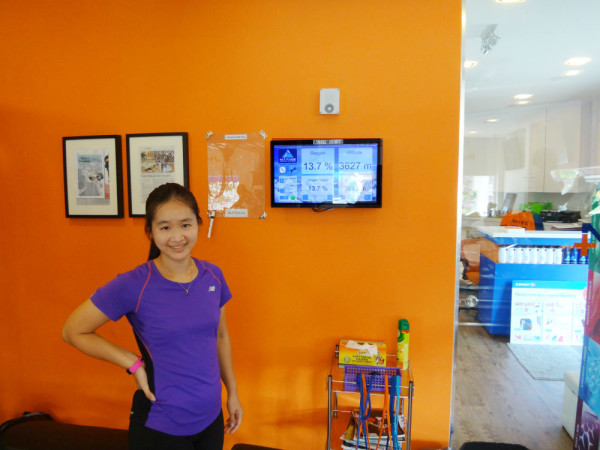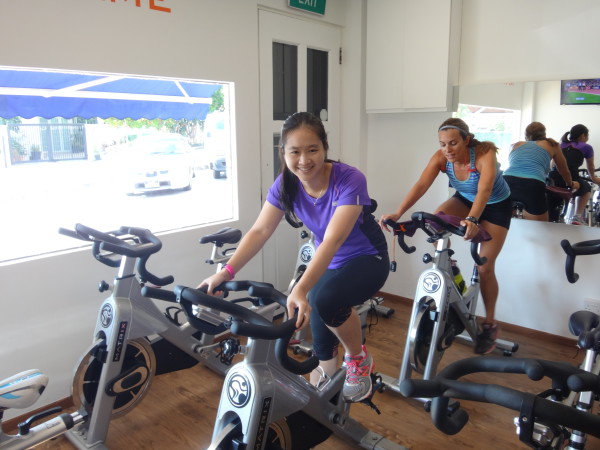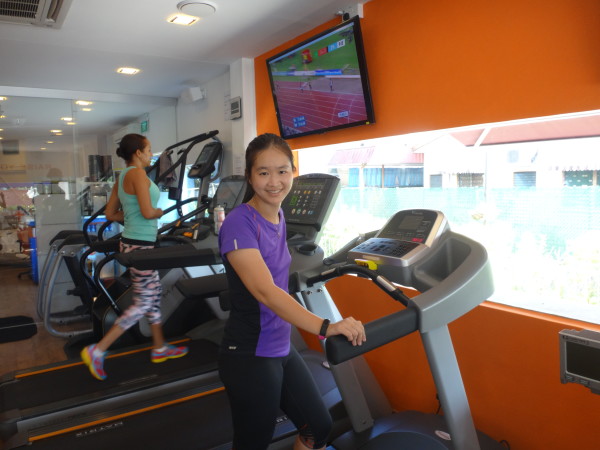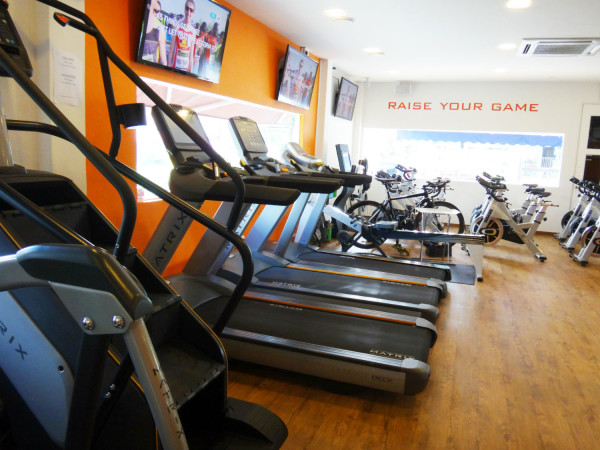It was only a 45-minute spinning class. Yet, approximately about halfway through the class, I found myself feeling a lot more breathless than usual. The more the spinning class progressed, the harder and harder it became to breathe and I was experiencing a bit of light headedness too. So it was a sheer relief when the class was finally over. Indeed, it was probably one of the hardest spinning classes that I have experienced, in a while.
This was my brutal introduction to a spinning class conducted at Altitude Gym – a simulated training facility in Bukit Timah, where gym users exercise in a chamber with reduced oxygen – mimicking an altitude of 3,500 metres above sea level.
Training at 3,500 metres above sea level
Explained Brian Angwin, 44, the Director of Altitude Gym – Singapore’s first and only high altitude gym, “This place looks just like any typical gym – except for the low oxygen level. Basically, Singapore is so flat that whenever you train outside, you are training at sea level – using 21 per cent oxygen. But in the Altitude gym chamber, we have it at 14 per cent oxygen, which is about 3,500 metres above sea level. So you have one third less oxygen than normally. It doesn’t sound like there’s much of a difference, but when you begin working out, you’ll feel the difference.”
I noticed the effect of exercising with a low oxygen level pretty quickly. Following my spinning class, I also did a bit of running on the treadmill, and even at an relatively easy pace of about 7 to 7:30 minutes per kilometre, I already found myself feeling slightly light headed after less than 10 minutes of running. I also felt the same on the elliptical and stair climbing machines.
Angwin explained that an average person needs at least about 16 per cent of oxygen to exercise comfortably. So with the level at Altitude Gym being set at 14 per cent, there isn’t enough oxygen to power the whole body efficiently. Said Angwin, “That means the brain has to decide how to distribute the limited amount of oxygen around the body to keep it moving. For example if you were running, the quad muscles will be used. So the body may reduce the digestive and urinary processes – to continue to power the quad muscles. These are some of the things that the body has to deal with, when you exercise at Altitude Gym.”
Benefits of training at higher altitudes
But despite the challenges and stresses the body has to go through, training with a lower oxygen level has its fair share of benefits. Said Angwin, “When you start exercising here, your heart rate gets up to the desired level much quicker than usual, and you will find the workout to be more intense than in an ordinary gym. This is a big benefit for athletes who work out here, as they can either push themselves harder, or work at a slightly lower intensity but still get the same workout.”
As well, altitude training also helps your breathing to improve, Angwin pointed out. He said, “When you are working out at intensity, you have to do deep breathing because of the limited oxygen level in the chamber. We all do shallow breathing when we are outside at 21 per cent oxygen. So after consistently training at Altitude, you will tend to go straight into deep breathing mode when doing sports – and so this carries oxygen around your body more efficiently.”
Angwin also pointed out that working out at Altitude Gym is a great way to lose weight too. He said, “If you go to a normal gym, you will burn calories during exercise, but this will stop after the session. At Altitude Gym, because of the intensity of the environment, your body will respond by raising its metabolic rate. This remains elevated for two to three hours after you leave the altitude chamber. So you will be working out for an additional two to three hours – unlike in a normal gym with 21 per cent oxygen level.”

According to this screen next to me, the oxygen level at the gym was exactly 13.7 per cent, when I was there.
Angwin said that many of the Altitude Gym’s members, have definitely noticed all of these benefits fairly quickly, after a minimum of about four to five sessions. Added Angwin, “And they now push themselves harder in the chamber, because when you discover that something has improved you, you want to keep on doing it in order to get to another level.”
Angwin’s own personal best marathon times have improved from 3 hours and 28 minutes, before he started working out at Altitude Gym, to 2 hours and 28 minutes – after a stint of altitude training.
Altitude Gym has helped triathlete Sara Ng
One athlete who uses Altitude Gym regularly is up-and-coming triathlete Sara Ng, 23, who is also a Personal Trainer there. She feels that Altitude has helped her greatly, in terms of her own sport.
Said Ng, “In terms of training, it has definitely helped me because training in here, the perceived efforts are higher so I can do the same training but it feels harder. That’s a good form of mental training as well as physical training for me. And when I go outside and do the same workout at the same effort, it feels a lot easier, both mentally and physiologically.
“Training is also a lot more time-focused and efficient, because when I am cycling for instance, I come into the chamber to do it and I don’t have to deal with the cars on the roads or the unpredictable weather,” Ng added.
Training in the chamber speeds up rate of recovery after an injury
In addition to helping her with her training, Ng also added that altitude training has also improved her rate of recovery, after sustaining an injury. Explained Ng, “When I dislocated my elbow in November last year, I was in the chamber a lot. So that helped to speed up the healing process. The doctor gave me eight weeks to recover but I was racing again within four weeks. It was definitely due to doing workouts in the chamber.”
Agreed Angwin, “The body will produce more red blood cells because that is the only way to cope in a low oxygen environment. The red blood cells promote recovery from injury and increase muscle density. They also do repair work for the muscles that break down during the workout. So the more red blood cells you have, then your recovery will be quicker. In fact, people can have a hard workout in the gym one day, but the next day they can also do another hard workout – because they feel more recovered than normal, due to their high red blood cell count.”
Blood oxygen levels and maximum heart rates are monitored at Altitude Gym
At the same time, the Altitude Gym is also a very safe place to workout. Angwin and his team take precautions to ensure that none of the gym users would, for example, start to feel dizzy or faint, over the reduced oxygen level. This is especially so for first-timers at the gym who are usually not used to the low oxygen level there.
Explained Angwin, “When people come in for the first time, we will ask them to fill out a medical questionnaire to see if that have significant medical issues. If there are none, we will start to monitor their progress in the chamber with an pulse oximeter.”
The pulse oximeter is a small device that an Altitude Gym user clips onto one of his or her fingers, to measure the percentage of his/her blood oxygen level as well as the heart rate. In a normal setting comprising of 21 per cent oxygen level, the reading on the pulse oximeter should be at a minimum of 99 per cent. However, when working out at Altitude, it is important that the reading does not fall below 80 per cent – as a reading that falls below that may cause dizziness and light headedness.
When I was having my trial session at Altitude Gym, I was given one of these oximeters too, and during the times when I was still feeling fine in the chamber, my reading fluctuated between 80 to 90 per cent. However when I started to feel light headed, I realised that my blood oxygen level had fallen to 75 per cent. So I backed down and took things a little easier for a while. That definitely helped.
For the heart rate reading, Altitude Gym would recommend their users to keep this to about 80 to 85 per cent of their maximum heart rate. Explained Angwin, “If you go beyond that, you are simply burning unnecessary energy and are not getting a cardio workout. So we would encourage you to keep an eye on that, as well as your blood oxygen levels. And if you’re not feeling well, you should come out of the chamber and return to normal oxygen levels, till you are feeling better again.”
Fees and Location of Altitude Gym
For those who are keen to experience altitude training and discover for themselves, what it is like to exercise with reduced oxygen, basic rates at Altitude Gym start at $130 per month for an annual membership package – during off-peak hours (Mondays to Fridays, 9am to 6pm). There is also a pack comprising of 10 sessions for $300, for people who are not able to commit to come to the Altitude Gym on a regular basis.
Stay tuned to another article on altitude training, where I’ll be writing about the experience of a couple of top runners who are currently using Altitude Gym, for their training.
Altitude Gym is located at:
11 Jalan Bingka,
Off Rifle Range Road, Bukit Timah,
Singapore 588908
Contact Altitude Gym at +65 9373 9034 or email the gym at info@altitude.sg for more information.
Thank you, Altitude Gym, for the trial session.





Hi Pris,
I PMed you via instagram but you may not have read it.
Would like to check if you’d be interested to try and rest in higher concentration oxygen inside our HBOTs. At the same time, it’d be good to listen to you about your experience inside the Altitude gym too!
Best regards,
Josh Lim